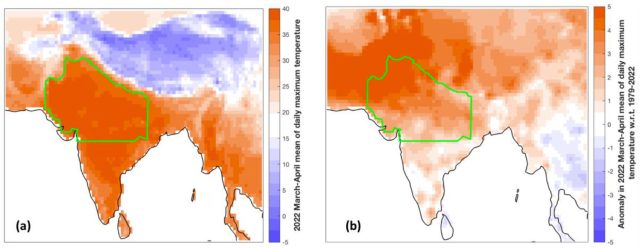
Spring has brought remarkably extreme heat to India and Pakistan this year. Unusually extensive heatwaves have followed one after another since March and are continuing well into May. The situation presents a conundrum for rapid studies of the role of climate change in this event, as we can’t yet put an end date on it. Nevertheless, a pair of studies have looked into the influence of the climate on March and April's heat.
Daily and monthly temperature records have been broken in many areas. Thermometers have hit temperatures as high as 120°F (49°C), and the heat has been accompanied by abnormally dry weather. Record-breaking heatwaves often coincide with drought, as the dry ground heats up even more without the cooling effect of evaporation. However, the lower humidity has reduced the heat's threat to human health, though at least 90 deaths have been reported so far, and that number is expected to rise.
Working outdoors has been extremely challenging, and the impacts of the slowdown have added up as the heat drags on. The effect on agriculture has been significant, with wheat yield losses already estimated at 10–35 percent in areas of northern India, for example. With Ukrainian exports down because of war, India had previously been planning to increase its own exports but instead instituted an export ban this month.
In Pakistan, the heat also caused outburst flooding from a glacial lake, destroying a major bridge and a number of buildings, including power plants.
The World Weather Attribution team applied its usual analysis to the heat through the end of April to tell us something about how it relates to climate change. These rapid reports are possible because the team uses the same (peer-reviewed) method each time. The goal isn’t to give a verdict on whether this weather event was “caused” by climate change—that’s not the right question to ask. Instead, these studies focus on whether we can expect to see more or less of this weather pattern in a warming climate. If the answer is "more," we can ask how strongly climate change loads the dice.

The study was limited to daily temperature data coverage from 1979 on for this area, stretching back to 1951 within India—less than ideal for picking out trends. But to estimate the effect of climate change, the researchers pulled from their usual large collection of climate models, including simulations with and without human-caused greenhouse gas (and sunlight-reflecting aerosol) emissions.
The analysis revolves around the statistics of an event’s rarity. From the historical data, this March–April heat is estimated at a 1 percent annual probability—what is commonly referred to as a “100-year event.” But in the model simulations of a 1.2°C cooler pre-industrial climate, heat this extreme would be about a 3,000-year event. In other words, climate change made this heatwave about 30 times more likely.
This can be repeated for model simulations of future warming. If the world warms to 2.0°C, this heatwave becomes another eight times more likely, meaning we should expect to see something similar almost every decade.
The UK Met Office released a similar analysis last week, though subtle differences in its approach make the final answers a bit different. It included a smaller collection of models and used the previous record April-May heat of 2010 as a benchmark.
The analysis estimated the 2010 heatwaves at about a 300-year event in a pre-industrial climate but just a three-year event in the 2013–2032 timeframe. That implies that climate change made breaking the 2010 record about 100 times more likely.
These results are no surprise, given that heatwaves are among the clearest climate-change-driven trends in weather extremes. But depending on when this string of heatwaves finally subsides, this event may look even more remarkable in the final accounting.
The World Weather Attribution paper highlights the need for life-saving adaptations in this region. Apart from the limited availability of air-conditioned spaces (made worse by rolling blackouts), roughly half of the population works outside. A number of cities in India and Pakistan have “Heat Action Plans” that include interventions like tree planting, cool roofs, event alerts, cooling centers with water, and giving hospitals resources to care for people. Efforts like these will only become more important as heatwaves continue to increase in frequency and intensity.
reader comments
199